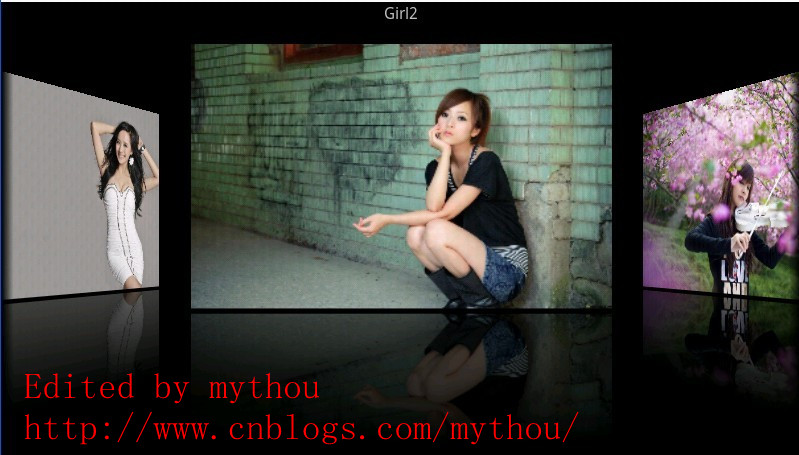今天因为要做一个设置开机画面的功能,主要是让用户可以设置自己的开机画面,应用层需要做让用户选择开机画面图片的功能。所以需要做一个简单的图片浏览选择程序。最后选用Gallery作为基本控件。加入了一些炫一点的元素,做成3D滑动效果。下面是Demo例子截图:


这个效果网上已经很多人做出来了,只是这次需要用到,所以自己也实践了一下(这里例子我也是根据网上一些资料编写)。特意找了几张美女图片给大家养养眼,O(∩_∩)O哈!下面针对一些关键代码进行简要说明,需要做这方面东西的朋友可以看看。这篇文章是实用性文章,理论分析不多。
(PS:新建的QQ群,有兴趣可以加入一起讨论:Android群:322599434)
1、重载Gallery类
因为需要加入倒影和3D切换的效果,因此我们需要重载Gallery类,其中有两个方法我们需要重写,一个是onSizeChanged(),另外一个是getChildStaticTransformation()。下面我们看看onSizeChanged()需要做的事情。
//Edited by mythou
//http://www.cnblogs.com/mythou/
@Override protected void onSizeChanged(int w, int h, int oldw, int oldh) {
//重写计算旋转的中心 mCoveflowCenter = getCenterOfCoverflow(); super.onSizeChanged(w, h, oldw, oldh); }
上面主要做的事情就是在改变大小的时候,重新计算滑动切换时需要旋转变化的中心。下面计算图片位置时,会重新计算。
//Edited by mythou
//http://www.cnblogs.com/mythou/
protected boolean getChildStaticTransformation(View child, Transformation trans) {
//图像的中心点和宽度 final int childCenter = getCenterOfView(child); final int childWidth = child.getWidth(); int rotationAngle = 0; trans.clear(); trans.setTransformationType(Transformation.TYPE_BOTH); // alpha 和 matrix 都变换 if (childCenter == mCoveflowCenter) {
// 正中间的childView transformImageBitmap((ImageView) child, trans, 0); } else {
// 两侧的childView rotationAngle = (int) ( ( (float) (mCoveflowCenter - childCenter) / childWidth ) * mMaxRotationAngle ); if (Math.abs(rotationAngle) > mMaxRotationAngle) { rotationAngle = (rotationAngle < 0) ? -mMaxRotationAngle : mMaxRotationAngle; }
//根据偏移角度对图片进行处理,看上去有3D的效果。 transformImageBitmap((ImageView) child, trans, rotationAngle); } return true; }
上面就是重载Gallery的时候,需要注意处理的事情,其实主要就是做图形变化,效果图里面的图片斜着显示就是这里处理的结果,目的就是让人看上去有立体感。
2、编写Adapter适配器
我们使用很多控件都涉及适配器,就是用来绑定数据源和目标控件的一个中间件。这里我们需要重载BaseAdapter作为我们Gallery的适配器。主要是处理源图像,加入倒影,生成新的数据源图片。
//Edited by mythou
//http://www.cnblogs.com/mythou/
public boolean createReflectedForAdapter() { final int reflectionGap = 4; final int Height = 200; int index = 0; for (Map<String, Object> map : list) { Integer id = (Integer) map.get("image"); // 获取原始图片 Bitmap originalImage = BitmapFactory.decodeResource(mContext.getResources(), id); int width = originalImage.getWidth(); int height = originalImage.getHeight(); float scale = Height / (float)height; Matrix sMatrix = new Matrix(); sMatrix.postScale(scale, scale); Bitmap miniBitmap = Bitmap.createBitmap(originalImage, 0, 0, originalImage.getWidth(), originalImage.getHeight(), sMatrix, true); //是否原图片数据,节省内存 originalImage.recycle(); int mwidth = miniBitmap.getWidth(); int mheight = miniBitmap.getHeight(); Matrix matrix = new Matrix(); // 图片矩阵变换(从低部向顶部的倒影) matrix.preScale(1, -1); // 截取原图下半部分 Bitmap reflectionImage = Bitmap.createBitmap(miniBitmap, 0, mheight/2, mwidth, mheight/2, matrix, false); // 创建倒影图片(高度为原图3/2) Bitmap bitmapWithReflection = Bitmap.createBitmap(mwidth, (mheight + mheight / 2), Config.ARGB_8888); // 绘制倒影图(原图 + 间距 + 倒影) Canvas canvas = new Canvas(bitmapWithReflection); // 绘制原图 canvas.drawBitmap(miniBitmap, 0, 0, null); Paint paint = new Paint(); // 绘制原图与倒影的间距 canvas.drawRect(0, mheight, mwidth, mheight + reflectionGap, paint); // 绘制倒影图 canvas.drawBitmap(reflectionImage, 0, mheight + reflectionGap, null); paint = new Paint(); // 线性渐变效果 LinearGradient shader = new LinearGradient(0, miniBitmap.getHeight(), 0, bitmapWithReflection.getHeight() + reflectionGap, 0x70ffffff, 0x00ffffff, TileMode.CLAMP); paint.setShader(shader); // 倒影遮罩效果 paint.setXfermode(new PorterDuffXfermode(Mode.DST_IN)); // 绘制倒影的阴影效果 canvas.drawRect(0, mheight, mwidth, bitmapWithReflection.getHeight() + reflectionGap, paint); ImageView imageView = new ImageView(mContext);
// 设置倒影图片 imageView.setImageBitmap(bitmapWithReflection); imageView.setLayoutParams(new GalleryView.LayoutParams((int)(width * scale), (int)(mheight * 3 / 2.0 + reflectionGap))); imageView.setScaleType(ScaleType.MATRIX); mImages[index++] = imageView; } return true; }
上面其实就是一个图片处理过程,主要做的事情就是生成倒影,效果图里面底下是有倒影的。就是利用上面算法生成。我们在适配器添加图片的时候,会把适配器原生图片进行处理,加入倒影的效果。这个我们在图片初始化的时候就可以调用处理,具体代码可以查看Demo里面的代码关系。
具体图片滑动的过程,Gallery会帮我们处理好,我们要做的事情其实就是提供添加了特效的图片数据源,以及处理3D显示的变化效果,最后都会提供View作为显示图像给Gallery用来显示。
今天主要是说说如何实现Gallery的3D显示切换,Demo的代码很多是基于网上一些现成效果,感谢这些分享成果的开发者。下面是Demo的下载,不清楚的可以把Demo下载下来,运行看看效果然后分析一下代码。代码不多,也不是很复杂。
Gallery3D例子代码:Grallery3DTest2013-7-19.rar
Edited by mythou
原创博文,转载请标明出处:http://www.cnblogs.com/mythou/p/3201126.html





 浙公网安备 33010602011771号
浙公网安备 33010602011771号